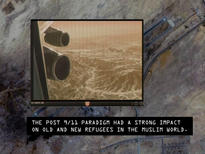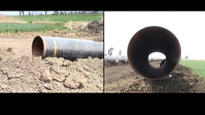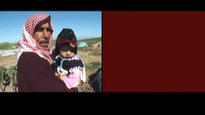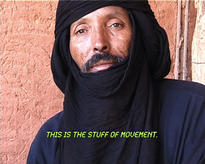URSULA BIEMANN @ AUSTRALIAN CINÉMATHÈQUE
SCREENING - DISTRIBUTION
To coincide with the opening weekend program of ‘21st Century: Art in the First Decade’, the Australian Cinémathèque presents Swiss artist Ursula Biemann. Biemann’s film essays explore issues surrounding migration, mobility, technology and gender.
Sahara Chronicle: A Collection of Videos on Mobility and the Politics of Containment in the Sahara (2006—2007)
This collection of twelve videos document the present sub-Saharan exodus towards Europe. The piece examines the politics of mobility and containment which lie at the heart of the current global geopolitics and takes a close look at the modalities and logistics of the migration system in the Sahara. The material is gathered during three fieldtrips to the major gates and nodes of the trans-Saharan migration network in Morocco, Niger, and Mauritania. Sahara Chronicle has no intention to construct a homogenous, stringent, contemporary narrative of a phenomenon that has long roots in colonial Africa and is extremely diverse and fragile in its present social organization and human experience. No authorial voice or any other narrative device is used to tie them together, the meaning is produced by the viewer who has to extract it from the interstices between the videos, i.e. from the connecting lines between the nodes where migratory intensity is bundled.
X-Mission (2008)
X-Mission explores the refugee camp as one of the oldest extraterritorial zones. Taking the Palestinian refugee camps as a case in point, the video engages with the different discourses – legal, symbolic, urban, mythological, historical – that give meaning to this exceptional space. According to international law, the Palestinian refugee represents the exception within the exception. Over the course of 60 years, they have had to build a civil life in the camps, fostering an intense microcosm with complex relations to homeland and diaspora. Given the vital connections between the separated Palestinian populations, the video attempts to place the Palestinian refugee in the context of a global diaspora and considers post-national models of belonging which have emerged through the networked matrix of this widely dispersed community. The video also reflects on the fine distinctions between humanitarian and artistic missions.
The Black Sea Files (2004–2005)
Black Sea Files is a territorial research on the Caspian oil as the world’s oldest oil extraction zone. A giant new subterranean pipeline traversing the Caucasus will soon pump Caspian Crude to the West. The line connecting the resource fringe with the terminal of the global high-tech oil circulation system, runs through the video like a central thread. However, the trajectory followed by the narrative is by no means a linear one. Circumventing the main players in the region, the video sheds light on a multitude of secondary sceneries. Oil workers, farmers, refugees and prostitutes who live along the pipeline come into profile and contribute to a wider human geography that displaces the singular and powerful signifying practices of oil corporations and oil politicians. Drawing on investigatory fieldwork as practiced by anthropologists, journalists and secret intelligence agents, the Black Sea Files comment on artistic methods in the field and the ways in which information and visual intelligence is detected, circulated or withheld.
Sahara Chronicle: A Collection of Videos on Mobility and the Politics of Containment in the Sahara (2006—2007)
This collection of twelve videos document the present sub-Saharan exodus towards Europe. The piece examines the politics of mobility and containment which lie at the heart of the current global geopolitics and takes a close look at the modalities and logistics of the migration system in the Sahara. The material is gathered during three fieldtrips to the major gates and nodes of the trans-Saharan migration network in Morocco, Niger, and Mauritania. Sahara Chronicle has no intention to construct a homogenous, stringent, contemporary narrative of a phenomenon that has long roots in colonial Africa and is extremely diverse and fragile in its present social organization and human experience. No authorial voice or any other narrative device is used to tie them together, the meaning is produced by the viewer who has to extract it from the interstices between the videos, i.e. from the connecting lines between the nodes where migratory intensity is bundled.
X-Mission (2008)
X-Mission explores the refugee camp as one of the oldest extraterritorial zones. Taking the Palestinian refugee camps as a case in point, the video engages with the different discourses – legal, symbolic, urban, mythological, historical – that give meaning to this exceptional space. According to international law, the Palestinian refugee represents the exception within the exception. Over the course of 60 years, they have had to build a civil life in the camps, fostering an intense microcosm with complex relations to homeland and diaspora. Given the vital connections between the separated Palestinian populations, the video attempts to place the Palestinian refugee in the context of a global diaspora and considers post-national models of belonging which have emerged through the networked matrix of this widely dispersed community. The video also reflects on the fine distinctions between humanitarian and artistic missions.
The Black Sea Files (2004–2005)
Black Sea Files is a territorial research on the Caspian oil as the world’s oldest oil extraction zone. A giant new subterranean pipeline traversing the Caucasus will soon pump Caspian Crude to the West. The line connecting the resource fringe with the terminal of the global high-tech oil circulation system, runs through the video like a central thread. However, the trajectory followed by the narrative is by no means a linear one. Circumventing the main players in the region, the video sheds light on a multitude of secondary sceneries. Oil workers, farmers, refugees and prostitutes who live along the pipeline come into profile and contribute to a wider human geography that displaces the singular and powerful signifying practices of oil corporations and oil politicians. Drawing on investigatory fieldwork as practiced by anthropologists, journalists and secret intelligence agents, the Black Sea Files comment on artistic methods in the field and the ways in which information and visual intelligence is detected, circulated or withheld.





-
Sat 18.12.2010
- Sun 19.12.2010
-
Practical info
Location:
Queensland Art Gallery
Queensland, Australia - Artists
- Works
- X-Mission: Symbolic Space
- Black Sea Files: File #4
- Sahara Chronicle: 04 Uranium Mine
- Black Sea Files: File #7
- Sahara Chronicle: 08 Octopus Processing Plant
- Black Sea Files: File #3
- Sahara Chronicle: 02 Desert Radio Drone
- X-Mission: Mythological Time
- Sahara Chronicle: 10 Oujda Frontierland
- Black Sea Files: File #5
- Black Sea Files: File #8
- Sahara Chronicle: 06 Iron Ore Train
- Sahara Chronicle: 09 Red Crescent Camp Inspection
- Sahara Chronicle: 12 Deportation Prison Laayoune
- X-Mission: Zone of Exception
- Black Sea Files: File #1
- Sahara Chronicle: 05 Touareg Border Guides
- X-Mission: Juridical Space
- Black Sea Files: File #6
- X-Mission: Post-National Space
- Sahara Chronicle: 03 Interview Adawa
- Black Sea Files: File #9
- Black Sea Files: File #2
- X-Mission: Prologue
- Sahara Chronicle: 01 Desert Truck Terminal
- Black Sea Files: File #0
- Sahara Chronicle: 07 Fishery In Eez
- Sahara Chronicle: 11 Architectures of Mobility